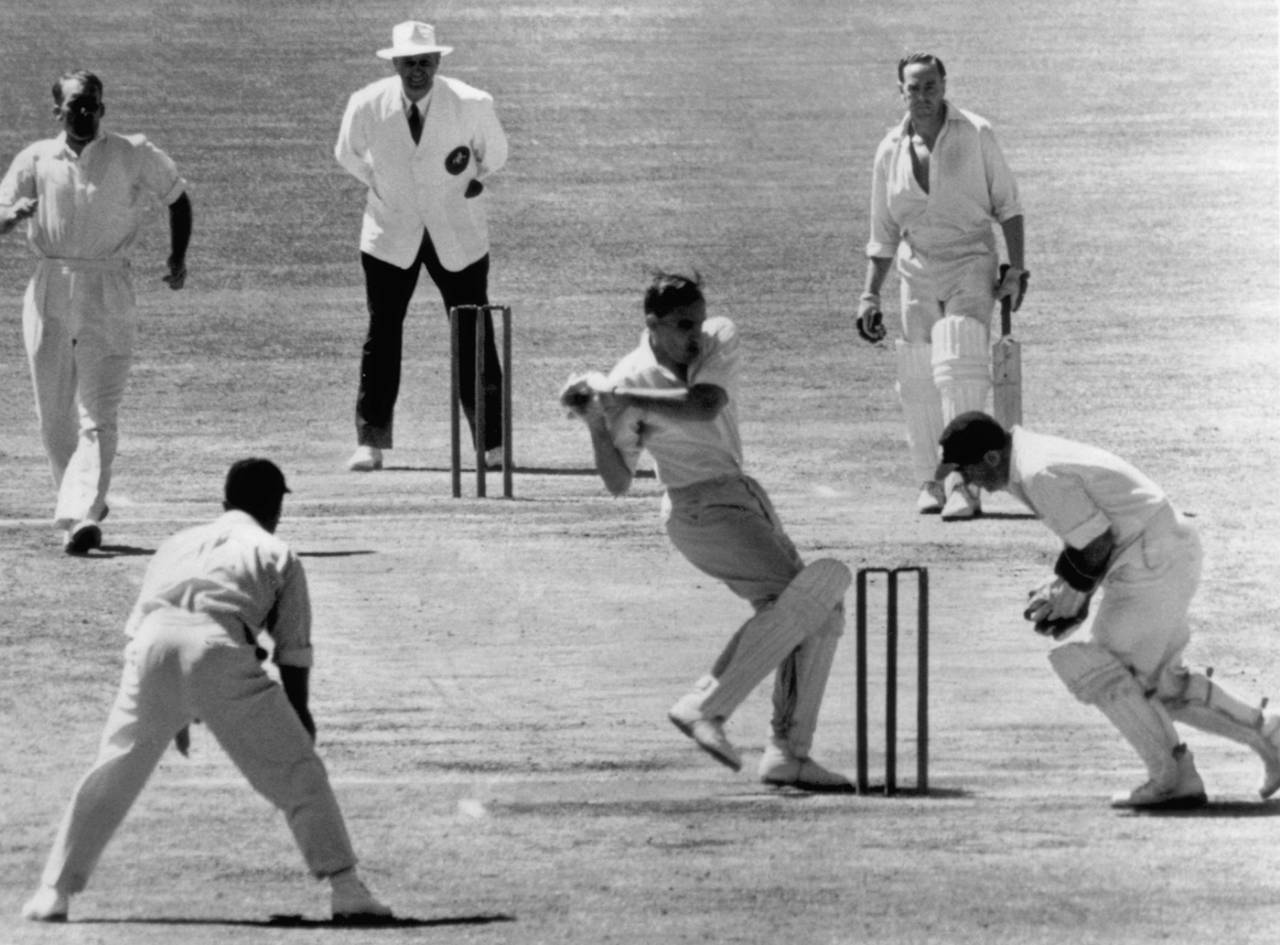The charm of cricket's most unobtrusive participant
Wicketkeepers are only noticed when they fumble. But they are the real attention magnets - or ought to be
Pete Langman
26-May-2016

Godfrey Evans catches the ball after Alan Davidson plays and misses off Johnny Wardle in Adelaide, 1955 • Getty Images
Every week, on these pages, in the pavilion and in pubs, cricketers recount their latest Homeric innings, that opening spell, occasionally that blinder of a catch. It's part and parcel of our game, and partly to parcel out warnings to the opposition: I'm on fire.
Achievement in cricket is Prufrockian, albeit not measured out in coffee spoons but in ones and twos. In this battle between bat and ball, when the irresistible challenges the immoveable, the casual observer would be forgiven for thinking that there are but two players who truly compete during any individual "play". As the batsmen come and go, the talk is of late swing, that perfect cover drive, that brutal lifter, that elegant late cut. The terminology to describe this cut and thrust abounds, and while those fielding are all too often relegated to the sidelines, it appears yet again that the beating heart of the team in the field has to work wonders to even get noticed. This is no more apparent than with Jonny Bairstow.
Bairstow's haul at Headingley last week is one of only 22 totals of nine or more catches in a Test - and only Mark Boucher, BJ Watling and Brad Haddin have, like Bairstow, achieved this twice. Compare this to the number of ten-wicket hauls for bowlers, or centuries, and it becomes clear just how special a performance this was. And yet the Man-of-the-Match award was won with a masterful century. The fact that it happened to have come from Bairstow's bat is yet more astonishing. Bairstow faced (with bat or gloves) 627 of the 1002 balls bowled in the Test, and languished at the non-striker's end for 160-odd. That's one hell of a contribution. As a bonus, remember that he took nine more catches than he conceded in byes.
I'm not here to talk about Jonny, however. It's just that his performance happens to have been very timely. Because us poor keepers don't get much in the way of glory, not much in the way of romantic terminology, oh no. We get, hmm, let me see: take, leg-side take, stop, catch, drop, stumping, gather, byes. We don't generally get accused of jug avoidance if we fumble that fifth dismissal. There's no invitation to a league dinner for our five-fers, nor, come to that, for a clean sheet.

Jonny Bairstow took nine catches at Headingley, but it was for his century that he got the match award•AFP
For a keeper, unobtrusiveness is taken as the sign of a good innings, and in some ways rightly so - it means no sitters dropped, no byes conceded. In other words, perception of a keeper's performance is primarily in inverse proportion to errors made. For all this, it is a supremely tough position to occupy. Paradoxically, for me, it is this very toughness that appeals.
I came to keeping late - that is, when I came to cricket (other than at school), in my late thirties. That's perhaps why neither my knees nor back have yet given in. I first kept wicket because nobody else would. I was awful (some might say little has changed), but I loved being in the thick of it. Over time I became less awful, until I can now proudly deem myself to be approaching mediocrity.
I'm often asked whether it's not too difficult a position for someone with Parkinson's, and it's true my delightful condition presents certain challenges - my foot movement is not the best, I have trouble diving, and my left hand is unreliably hard - but it's also, paradoxically, ideal. Among the many cricket-unfriendly symptoms Parkinson's presents, stiffness and freezing are perhaps the most irritating. Standing about in the outfield, getting mildly chilled, tends to make my body seize up, to the point where bending down to pick up the ball is often an action that fails to happen. Similarly freezing, where typically the feet remain rooted to the floor. The constant movement of keeping and concentration required, however, seem to keep the Parkinson's at bay, if only in the middle. I would be lying if I were to claim any natural affinity for the position, however. I simply love it.
Watching a true keeper, however, is a sublime experience. It's as though the gloves seduce the ball, drawing it towards them like a Venus flytrap taking its sustenance. Watching Sarah Taylor at Wormsley once, I was reminded of David Gower's elegance, his insouciance. Batsmen? Bowlers? They merely borrow the ball - its true home is in the gloves. The thud of leather on glove is the true sound of cricket. On Sunday I played in a game in which no fewer than 15 catches were dropped. One chance was taken. By the keeper. Me. It went into the opposition's book as lbw. What does a poor keeper have to do?
Ask Jonny: he knows.
Pete Langman is the author of The Country House Cricketer. All profits go to help fund research into Parkinson's disease. @elegantfowl